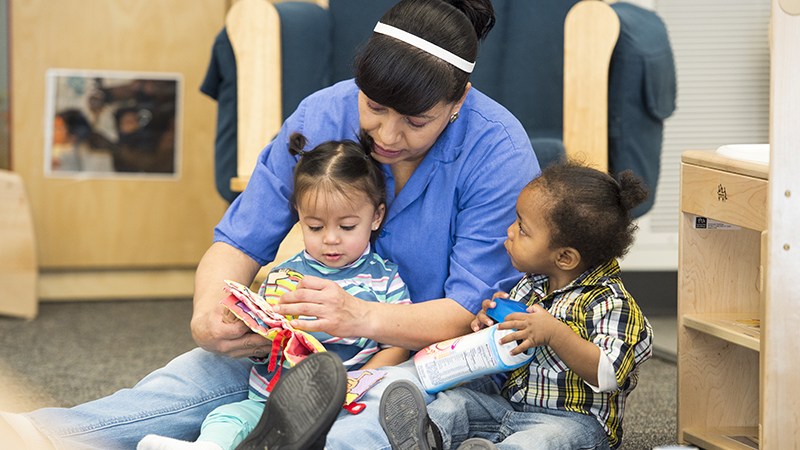
Photo courtesy of Clayton Early Learning
Photo courtesy of Clayton Early Learning
Late last month, Clayton Early Learning, one of the top-rated child care programs in the state, said that it will close one of its two facilities, serving the far northeast Denver community of Green Valley Ranch. Many of the children there were offered a spot in Clayton Early Learning’s flagship center on Martin Luther King, Jr. Boulevard. Some were not.
Even before this news, it was hard, bordering on impossible, for many Colorado families to find consistent and high-quality day care and preschool for infants and toddlers under the age of 5. As Chandra Thomas Whitfield reports for our website, around half of Coloradans live in what is sometimes called a “child care desert”—neighborhoods where there aren’t enough licensed day cares to meet the needs of the families living there.
Far northeast Denver and neighboring parts of Aurora make up one of them, and Whitfield tells the story of Sheila Custard, a working mother from Green Valley Ranch who scrambles to find child care anew each week for her daughter Jaelyn because there’s no single, consistent option that serves them. Whitfield rightly focuses on the impact of child care deserts on the health of low-income families and people of color—who are more likely to find that their infants, toddlers and preschool kids have no place to go, and more likely to be financially and otherwise stressed by the poor options remaining to them.
But as Chalkbeat’s excellent story on the closure of the Clayton facility makes clear, it’s not only low-income families that suffer under our patchwork system of child care funding in the state; it’s middle-class families, too.
It was mostly wealthier, private-pay families who were told that Clayton Early Learning could no longer accommodate them. Children from families with lower incomes who qualify for Early Head Start and Head Start were offered spots at the center’s flagship campus (which is at least 20 minutes by car from even the closest part of Green Valley Ranch).
That’s because Clayton’s administrators found that city and federal funds combined could be stretched to cover the cost of enrollment. Private tuition of $1,000 to $1,200 a month, meanwhile, didn’t go far enough to cover the expense of the kind of comprehensive, high-quality care that Clayton provides, which goes beyond what most day cares can offer: Clayton hires highly qualified teachers, offers small class sizes and provides health care and other kinds of support to enrolled children and their parents.
Clayton’s decision to stop accepting tuition-paying students means that the center will now look more like other day cares in the metro area and the country: segregated.
That’s an outcome nobody wants, including Clayton’s administrators. “We don’t believe it’s the right way to go to segregate kids based on their race, income, or anything else,” Clayton’s President and CEO Charlotte Brantley told Chalkbeat.
The financial burdens facing Clayton aren’t unique; it’s no accident that many American day cares and preschools are monochrome, even as the racial diversity of our children expands. A recent study by the Center for Education and Civil Rights analyzed a large amount of data collected by the U.S. Department of Education and found that nearly half of all children enrolled in public preschools are in racially isolated schools—where children are either more than 90 percent non-white or more than 90 percent white.
Children in families with lower incomes, meanwhile, are more likely to be enrolled in lower quality preschools.
Sometimes, well-intentioned policies contribute to these divisions. Head Start enrollment, for example, has historically been reserved for children whose families are living in poverty or close to it, as a way to help bridge achievement gaps. But research has shown that mixed-income settings provide important benefits to even the youngest kids. In response to concerns about segregation, regulators moved in September to make Head Start centers more accessible to tuition-paying families.
When I was looking for day care for my own child, now 3 years old, most of the ones I saw appeared segregated by income and race. Many of the day cares with openings wouldn’t accept reimbursement from the state’s Child Care Assistance Program, or CCCAP, which assists families that have low incomes. Others did accept CCCAP, but they were oversubscribed and had long wait lists. Either way, the racial isolation was usually clear.
Yet when I visited Clayton Early Learning’s Cole campus, the caring staff was on display, as were the beautiful facilities, the support provided to families, and a whole lot of apparently content kids of many races. My son has been on their wait list for the past year and a half. And because we were intending to pay tuition, he no longer has a shot at enrolling.
For families in a position to pay full freight for child care, there are usually other good options available. That was true for us. But when we deprive our kids of integrated, high-quality day cares and preschools, we make it more likely that their first friends look like them. We’re limiting their exposure to other languages and cultures that can expand their minds and make them more curious, empathetic adults. And we’re helping to lock in a system of unequal education that lasts for lifetimes.
What a loss.
Related Story: Almost Half of Coloradans Live in ‘Child Care Deserts’